Fascinating -albeit deeply depressing- news stories have been emerging recently in mainstream media about the conflict between, on the one hand, the development of digital society and, on the other, the protection of the environment and of key natural resources. The stories and scientific studies reveal the energy and water voracity of ChatGPT, the threat that sea level rise poses to internet infrastructure, the water wars in Taiwan between microchip manufacturers and local farmers, etc. The most visible and debated facet of the debate are the data centres. This Summer, people in Uruguay were protesting against the plan to build a Google data centre that will use millions of litres of water a day while the country was suffering its worst drought in 74 years. And with temperatures rising in Europe and elsewhere, the energy-demanding cooling systems of data centres are worrying local populations. In particular, when the tech giants’ claims of a 100% sustainable activity mean that they hog the green power infrastructure that could benefit local taxpayers.
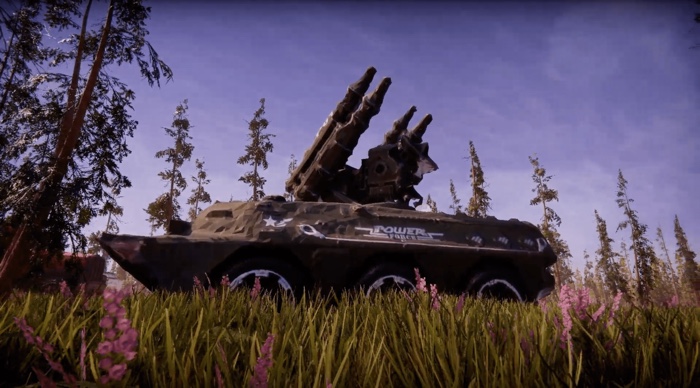
Alexander Walmsley, Memory Architecture, 2023
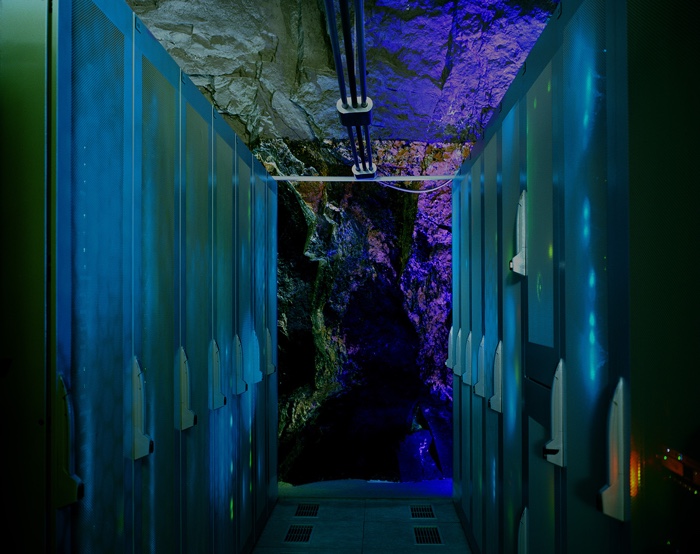
Yann Mingard, Server cabinets, Bahnhof.se, “Pionen”, Stockholm, Sweden, 2011. From the series Deposit
A few years ago, data centre providers and operators started moving their infrastructures to Northern countries such as Sweden where sub-zero temperatures, cheap hydroelectric power and fast fibre-optic network ensure lower carbon footprint. While boasting about their new energy-efficiency and green credentials, tech companies neglect to mention that their main objective is still to make us consume and generate more data and that the sea ice cover is rapidly melting in the Arctic.
Alexander Walmsley, Memory Architecture (Full-length version), 2023
Alexander Walmsley, an artist and programmer with a background in anthropology and archaeology, has been looking into the boom in data centre construction in the Arctic during an artist residency at the Moskosel Creative Lab in Moskosel, a small town in the North of Sweden.
His short film Memory Architecture explores the structures of data and memory. Named for the set of methods used to implement computer data storage, Memory Architecture explores the phenomenon of remote data centres near the Arctic Circle through the fictional story of a surveyor who has travelled north to survey a site for the building of a server farm, only to find that the systematic task of transforming the terrain into a digital model quickly becomes an impossible challenge as the landscape itself shifts beneath his feet.
Neither speculative nor documentary, the fiction propels the very rational narrator into a world altered by Swedish folk tales and Gothic literature. By adopting this oblique strategy to look at tech infrastructures, the film makes tangible a future that is drifting away from logic and certainties. I asked Alexander Walmsley to tell us more about the video:
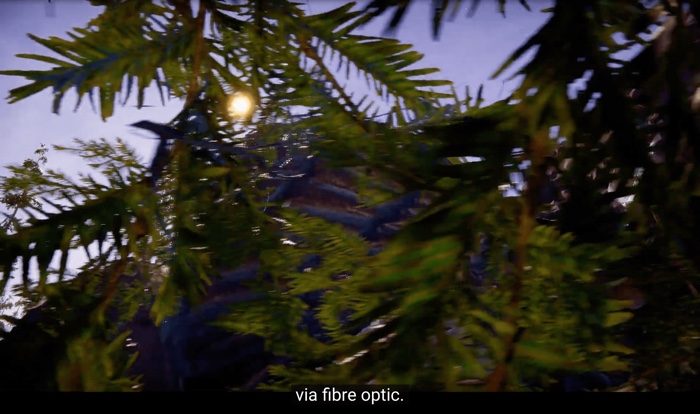
Alexander Walmsley, Memory Architecture, 2023
Hi Alex! What was the motivation behind the work? How did you find yourself in a remote village located in the North of Sweden to develop a work about data centre construction currently taking place in the Arctic?
The phenomenon of data centres being hosted in arctic areas is an interesting inflection point where narratives of climate change cross over with narratives of the global cloud infrastructure. One of my recurring topics of interest in the past has been the digitisation or “virtualisation” of cultural heritage and how this conflates categories of “data storage” with “memory”. The arctic data centre phenomenon has been developing over a number of years and seemed to provide a relevant but contrasting angle on this issue, with data centres accounting for more global carbon emissions than aviation and therefore being a very direct cause of the warming taking place in those arctic areas in which they are being built! This is the paradox that first attracted me to the subject.
The opportunity to explore the subject further came in the form of a residency at the Moskosel Creative Lab in the village of Moskosel in northern Sweden. I was generously hosted in the lab for 3 weeks in February and got the chance to work on the film as well as experience life there during the coldest (and darkest) month of the year (it was minus 22 degrees when I arrived…).
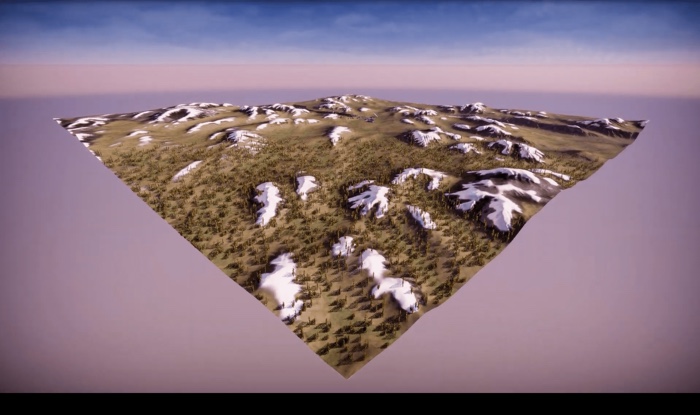
Alexander Walmsley, Memory Architecture, 2023
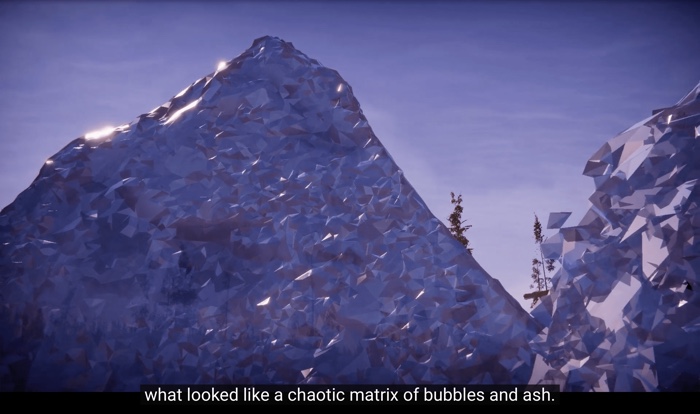
Alexander Walmsley, Memory Architecture, 2023
Why did you choose to work with a game engine? What makes it an appropriate medium for the project?
Game engines are an important part of my practice and more broadly are increasingly being used as environments for rendering entire films. They are powerful things and one interest in this project was the ability to combine different kinds of data within the same visual environment – film, photography, 3D models, satellite data – something that they are built to do. They also have a very different relationship to the world than do lens-based media – namely, there is no assumption that what you see in a game engine represents something in the world. Therefore for me game engines often present a way of transforming material from the physical world (e.g. photogrammetry scans, which I use a lot in the film) into objects and environments that are freed from their representative role and can therefore take on new meanings.
The film reminded me of a literary genre that is called fantastique in French (with novels or short stories by Prosper Mérimée, Jean Ray, Guy de Maupassant but also Lovecraft, etc.) Was that the style of narrative you were looking for?
Yes, there are elements of the fantastique and also of Gothic literature that I find very intriguing and fun to play with. There is the supernatural horror element that is prevalent in Lovecraft as well as authors such as Karen Blixen and Mary Shelley, but also the narrative device of a slightly naïve narrator going off to a distant location, often under the pretence of scientific investigation (this is at least common in 18th/19th century Gothic literature).
A more direct starting point for the narrative was Swedish folk tales, many of which originate in the Middle Ages and were transcribed by a number of different authors in the 19th century. What was particularly remarkable to me was the prevalence of mythological creatures that were associated with or even disguised themselves as different parts of the landscape. Nordic folklore seems replete with them: trolls disguised as or living in mountains; shapeshifting water spirits that can transform into different animals (known as Nøkken); human-like spirits that can transform into sand to pass through keyholes (Nattmara). This tradition was certainly an early source of inspiration.
The film is also anchored in reality. One of the topics it touches upon is the installation of cloud architecture in the Arctic. How big is the phenomenon?
It is a phenomenon that has been growing for a while, but taken off particularly in the past 10 years or so. The Nordic countries have worked particularly hard to attract clients from the sector – Facebook founded its first European data centre in the northern Swedish town of Luleå in 2013 and has since then expanded the campus significantly. The world’s allegedly largest data centre is currently being planned in the remote Norwegian town of Ballangan, above the arctic circle.
An interesting sub-phenomenon is data centres built in the empty caverns left from mining operations in the area – another industry that has brought those countries a significant amount of wealth over the years. The main draws of the area are its cool climate, which helps to naturally cool the servers, as well as cheap electricity (often provided through renewable resources). Among other companies, I found out that Github has something called an Arctic Code Vault, which stores all active public code repositories that were hosted by the platform on 2 February 2020.
The idea of taking advantage of the Arctic’s cool climate for storage of data and non-data objects is much longer however. The cool climate also slows the process of decay. The Global Seed Vault on the island of Svalbard, Norway, is an example of the archiving of organic material as a kind of “back-up drive” for earth’s plant biodiversity.
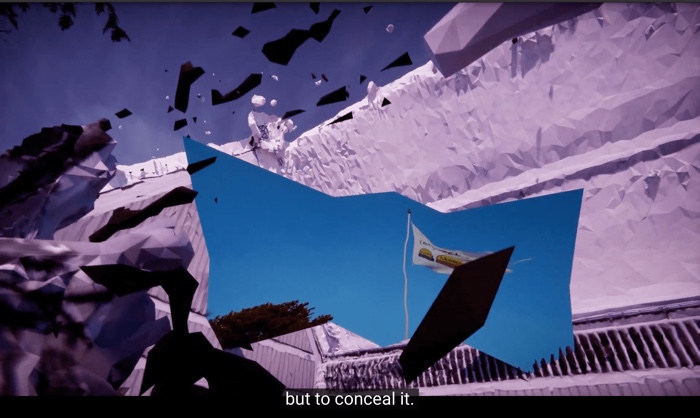
Alexander Walmsley, Memory Architecture, 2023
Memory Architecture briefly hints at global warming which made me wonder about the social and ecological impacts of all these data centres on the Arctic area. Do local communities living there welcome these businesses? And what is the carbon footprint of these constructions? Are these issues you’ve been looking into as well?
These are interesting questions into which I was not really able to dive deeper. There is undoubtedly a lot of local and national politics at work. The village in which I was staying used to be much bigger and was home to people working in the region’s once-burgeoning forestry industry. That seems to have declined significantly in recent years, and data centres are being pushed on a regional level as a new economic possibility for the area. For some towns it seems to be working – Luleå, where Facebook has their European data centre, is a big contributor to Sweden’s GDP (also because of the mining industry there).
As a rule, figures for the carbon footprint of the industry as a whole are much easier to come across than the figures for individual data centres. However, the data centre I mentioned above (the Kolos data centre in the town of Ballangan, Norway) claims that at full capacity it will draw on 1000 megawatts of energy – about as much as 100,000 (US) households – but currently is operating at only a fraction of that. And data centres themselves make up only about 15% of the carbon emissions of the IT industry.
How much does the narrative of the short film reflect your own experience in Moskosel: the working process to document the landscape, the meeting with scientists bringing back ice cores to study, the history of mining activities in the region, the existence of an AI calculating the extractive potential of landscapes based on satellite data…?
The narrative of the film is a hybrid thing assembled from previous events in my life, sources that I came across during the residency, and fictitious plot devices that I invented based on these. I studied anthropology and archaeology at university and for a while worked as a surveyor on archaeological sites in the UK – the process that the main character is enacting in the film comes directly from this experience. The ice cores also are sourced from my previous archaeological studies, as they are used to reconstruct (pre-)historical environmental conditions. And the satellite data-reading AI is a small fictional extrapolation on something I came across during (somewhat tangential) research for a PhD at the Film University Konrad Wolf in Germany.
Moskosel itself provided me with the entire visual and auditory context for the work. I spent the weeks I was there walking through the village and surrounding countryside making scans and field recordings, much in the way the main character surveys the landscape in the film (although perhaps less structured). The narrative itself however is fundamentally fictional – there is no data centre in Moskosel, nor are there plans to build one (I don’t believe). So in the film it functions as a surrogate for phenomena that are taking place in the wider area.
Why did you decide to center the narrative on difficulty/impossibility to produce an accurate map of a landscape? What kind of lessons should we draw from this?
After I had accumulated a fair amount of background research on this phenomenon, the time came when I felt compelled to do something with it, rather than just let the information pile up. I decided that to try and address the subject head on would not only come with a certain responsibility to represent the situation as it is, but perhaps also to reach for some kind of concrete solution. Ultimately I don’t feel that this is what art is equipped to do. Instead, I wanted to use the context of this phenomenon I had researched to explore the ambiguity between “data” and “memory” and the process by which the physical world is eaten up and transformed into digital media and stored on remote servers like the ones being built in the arctic. For me this ambiguity and the conflict inherent between these two categories opened a significant conceptual space that could be explored through a fictional narrative. The difficulty of mapping the terrain accurately is perhaps therefore the difficulty of mapping one category onto another, or maybe a parable of digitisation, or perhaps a metaphor for the structural differences between a model and the thing-being-modelled.
Thanks Alexander!
